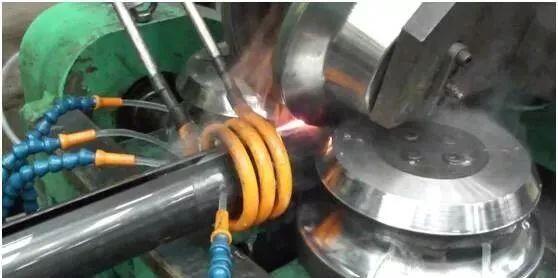Electric Resistance Welded Pipe & Tube, abbreviated as ERW tube, is a type of steel pipe formed by rolling a steel strip or plate into a tube blank using high-frequency electric current heating (resistance heating effect) and then welding the edges of the tube using extrusion rollers under pressure. This process is a form of pressure welding and is widely used in oil and gas transportation, building structures, and automotive manufacturing.
The core feature of ERW tube is a straight longitudinal weld seam. This weld seam is formed using the electric resistance welding process, unlike
seamless pipe, which has no weld seam, or spiral weld seam, as in spiral welded pipe.
Process Features:
1. Filler-free welding: The weld seam is formed by directly melting the base metal, requiring no additional welding material, and its mechanical strength approaches that of the base metal.
2. High-frequency induction or contact resistance heating: The current frequency is typically 350-450kHz, which provides high heating efficiency and low energy consumption.
3. Forged structure weld seam: A dense weld seam is formed through extrusion. Some high-end products require post-weld heat treatment to improve toughness.

How is ERW produced?
Manufacturing Process for Electric Resistance Welded Tubes:
1. Raw Material Preparation: Coiled steel strip or plate is used as the raw material.
2. Forming: The steel strip passes through a series of forming rollers, gradually bending it into a round, square, or other desired cross-sectional shape.
3. Welding: As the edges of the tube are pressed together, a high-frequency current is passed through a pair of copper electrode wheels or an induction coil. Because the electrical resistance at the contact edges is greatest, this area is instantly heated to a near-molten plastic state (approximately 1350°C-1400°C). The squeeze rollers apply intense pressure to the heated edges, causing the metal atoms to diffuse and crystallize under the high temperature and pressure, thus achieving a solid-state metallurgical bond. Please note that the parent metal is typically not completely melted during this process.
4. Post-Processing: The welded tube undergoes a series of processing steps, including:
Internal/External Deburring: This scrapes away excess metal displaced during welding.
Cooling and Sizing: Cooling and sizing mills are used to ensure accurate dimensions and roundness.
Cutting: Cutting to the desired length. Heat Treatment: The weld seam is normalized online to relieve stress, refine the grain size, and ensure that the weld properties are consistent with those of the base material.
Quality Inspection: Hydrostatic testing, eddy current testing, or ultrasonic testing are performed to ensure weld quality.
Classification of Electric Resistance Welded Pipe:
Based on the current frequency and forming process, electric resistance welded pipe can be divided into the following categories:
High-Frequency Electric Resistance Welded Pipe (
HFW pipe): Uses a high-frequency current (>100kHz) and is suitable for thin-walled pipe production, offering consistent weld quality.
Low-Frequency Electric Resistance Welded Pipe: Uses a lower current frequency and is primarily used for thick-walled pipe production.
Classification By Shape:
ERW Round Pipe: The most common type, used for fluid transport and structures.
ERW Square and Rectangular Pipe: Round pipe is formed into a square or rectangular cross-section through cold rolling, primarily for building structures, machinery frames, and other applications.
Classification By Precision:
Ordinary Welded Pipe: Typically used for low-pressure fluid transport, structural supports, and other applications.
Precision welded pipe (Cold drawn ERW pipe): Generally manufactured using a cold drawing process, it offers high dimensional accuracy and a smooth surface finish. It is used in automobiles, furniture, and other applications.
Advantages and Disadvantages of Electric Resistance Welded Pipe:
Advantages:
High Efficiency and Low Cost: The production process is continuous and highly automated, resulting in costs significantly lower than seamless steel pipe.
Good Weld Quality: Modern high-frequency welding technology enables weld strength comparable to that of the parent material.
High Dimensional Accuracy: Uniform wall thickness, good concentricity, and a smooth surface finish.
Flexibility: The same production line can produce a variety of pipe specifications.
Disadvantages and Limitations:
Weld Seam: The weld area exhibits microstructural differences from the parent material (even though the structure is very similar after heat treatment), potentially becoming a potential weak point under extremely harsh conditions (such as ultra-high pressure and severe alternating loads).
Sensitive to Raw Material: The quality of the steel strip edge directly affects weld quality.
Historical Prejudice: The poor quality of early low-frequency welded pipes has led some to still harbor the stereotype of ERW tube as being of inferior quality. However, modern high-frequency welding technology has completely eliminated these issues.
Applications of Electric Resistance Welded Pipe:
Due to its economical and reliable performance, electric resistance welded pipes are widely used:
Low-medium-pressure fluid transportation: oil, natural gas, water, steam, etc.
Building Structures: beams, columns, scaffolding (primary applications for ERW square and rectangular tubes).
Machinery Manufacturing: frames and supports for various mechanical equipment.
Automotive Industry: axles, drive shafts, bumpers, etc.
Furniture and Appliances: chairs, tables, shelves, refrigerators, and air conditioner structural components.
Conclusion:
Electric resistance welded pipe (ERW) is an efficient and economical steel pipe welded using resistance heat and pressure. It features a single longitudinal straight weld seam and is one of the most widely used steel pipe types in modern manufacturing. High-quality ERW tube is a highly cost-effective option for most low- and medium-pressure and structural applications. However, for extreme operating conditions such as ultra-high pressure and supercritical conditions, seamless pipe is still required.
Read more: SAW vs ERW and EFW Welded Steel Pipe or ASTM A53 GR.B ERW Steel Pipe


